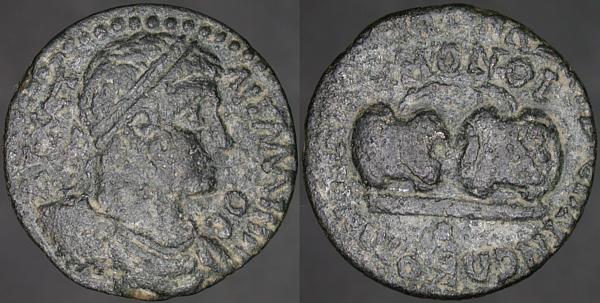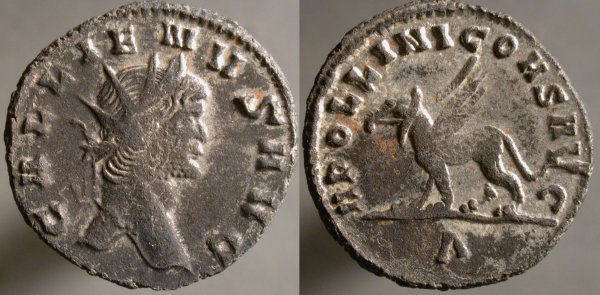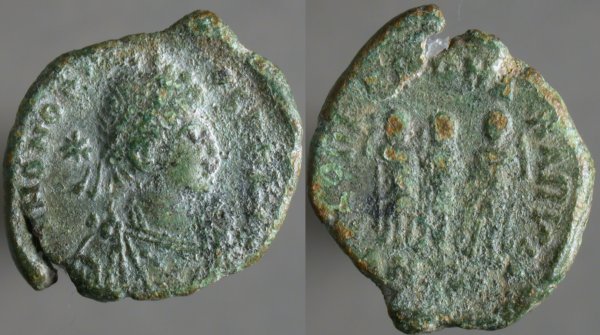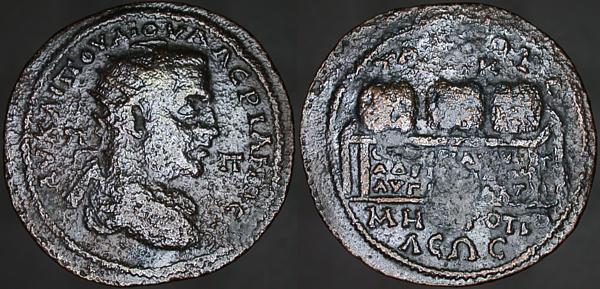Friday, September 29, 2006
Æ24, Homonia between Hierapolis in Phrygia and Smyrna in Ionia, Gallienus, ...
SNG von Aulock 3669

AV K Π ΛI ΓAΛΛIHN / OC, Diademed draped cuirassed bust right | IEPAΠOΛEITΩN X ZMVPNEΩN NEΩKOPΩN, Two prize crowns, palms protruding. OMONI / A in fields.
Before the Romans conquered the Greek world, Homonia represented an alliance between cities that could have military, commercial, and cultural aspects. After the cities were part of the empire, their military firmly under Roman control and business nearly as tightly controlled, only cultural activities seem to have been part of Homonia, and only prize-awarding contests at that.
Those contests, selling goods & services to the visitors to those contests, had enough value that coins of two cities in Homonia are not difficult to find.

AV K Π ΛI ΓAΛΛIHN / OC, Diademed draped cuirassed bust right | IEPAΠOΛEITΩN X ZMVPNEΩN NEΩKOPΩN, Two prize crowns, palms protruding. OMONI / A in fields.
Before the Romans conquered the Greek world, Homonia represented an alliance between cities that could have military, commercial, and cultural aspects. After the cities were part of the empire, their military firmly under Roman control and business nearly as tightly controlled, only cultural activities seem to have been part of Homonia, and only prize-awarding contests at that.
Those contests, selling goods & services to the visitors to those contests, had enough value that coins of two cities in Homonia are not difficult to find.
Thursday, September 28, 2006
Silvered Æ antoninianus, Gallienus, Rome, Göbl 718b

GALLIENVS AVG, Radiate head right | APOLLINI CONS AVG, Gryphon walking left. Δ in exergue.
The last time I posted an example of Göbl 718b it was much inferior to this. I was quite pleased to purchase this, though I wish it photographed a little better. The light-colored material on either side is a remnant of the original silver surface, quite clear in the hand, though it looks more like a light covering of sediment here.
It's perhaps reassuring to note that the seller's photograph was no better in that regard. I've learned to respect his skills, and if my own are equal, in at least one aspect, then my purchase some years ago of a Nikon Coolpix 995 and my insistence on not replacing it since, are not proven wrong.
Here, a comprehensive site on the "Zoo series," which featured real animals and mythological ones such as this gryphon.
Wednesday, September 27, 2006
Æ4, Honorius, uncertain mint, uncertain reference

[D N] HONOR[IVS P F AVG], Diademed, draped bust right, star in left field | GLORIA ROMANORVM, Three emperors standing, exergue off flan.
Flavius Honorius was the younger son of Theodosius I, and was something of a disappointment after his father, who'd seemed to presage better times.
Honorius spent much of his (long) career hiding out from people he'd introduced to power, leading to such entertainments as the Sack of Rome in 410, after Honorius had fled Rome for Ravenna.
Honorius continued to reign over his rather diminished empire, abandoning the Britons to fate, for instance, dying of apparent natural causes in 423, leaving an empire which, to borrow a quote, might get better but which would never get well.
Tuesday, September 26, 2006
Æ31, Tarsus in Cilicia, Valerian, Lindgren III A932b

AV KAI ΠOV ΛI OVAΛEPIANOC CE, Radiate draped cuirassed bust right, Π before and behind | TAPCOV / A M K / Γ Γ / MHTPOΠO / ΛEΩN, Three prize crowns atop table inscribed CEVHPIOΛV / AΔ PIAEΠ IXIPIA / AVΓ OVCTIAKTIA
There are few definitive statements that can be made about provincial coins of the Roman empire. While there are no precious-metal provincials from the time of this coin, 253 or later here's a provincial of Trajan Decius, 250-251 CE, of an alloy that can either be called poor silver or good billon.
But this, this is clearly bronze, with a surface not much superior to that on the coin I posted on Friday.
Monday, September 25, 2006
Billon antoninianus, Gallienus, Mediolanum, Göbl 1018c

GALLIENVS AVG, Radiate head left | LEG XIII GEM VII P VII F, Victory walking right holding wreath aloft in right hand and palm over left shoulder. Lion walking left to meet her.
The "Legionary Series," a series of coins that honor the legions that fought alongside Gallienus in the West, fascinate me more than any other imperial issues of the family. The coins show the badges of the legions on the reverse, and these may be accurate representations of those badges that would have looked right to the legionaries themselves.
While features of the designs are familiar, they're often seen in designs not seen on any other Roman coin, as the Victory and lion scene here.
Also interesting is Legio XIII Gemina, who'd crossed the Rubicon with Caesar in 49 BCE. It's reasonable, I think, to imagine the story was taught to every new recruit.

